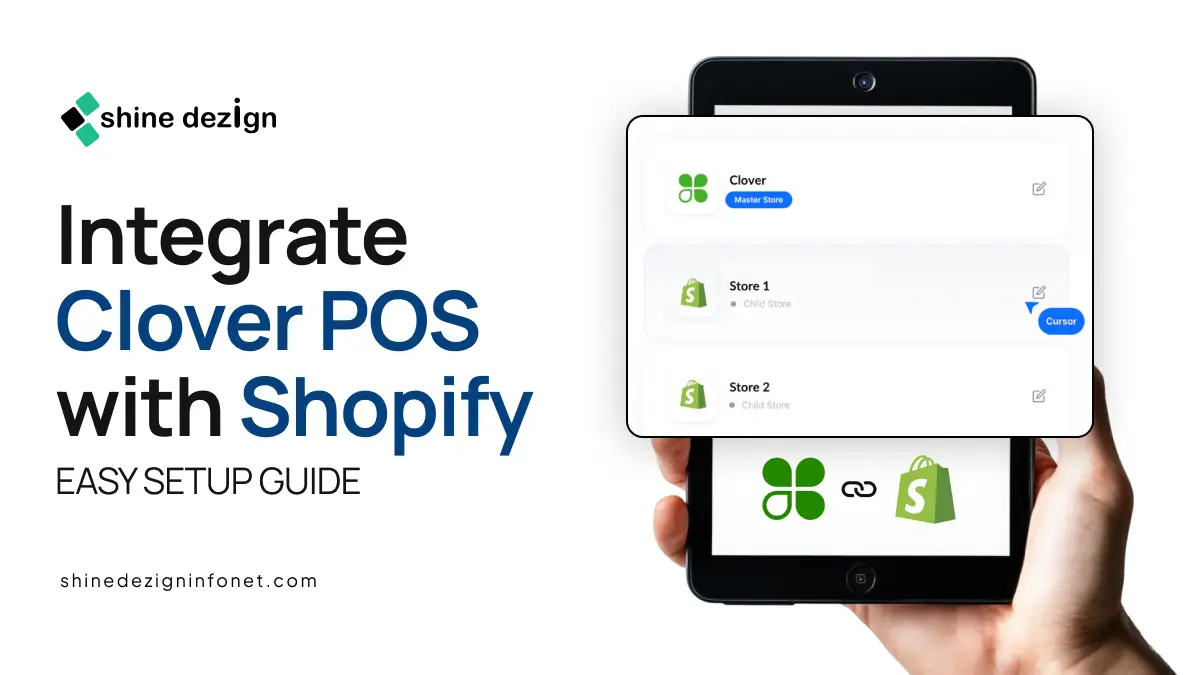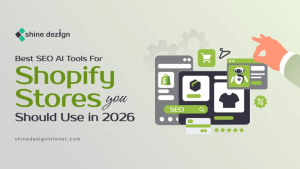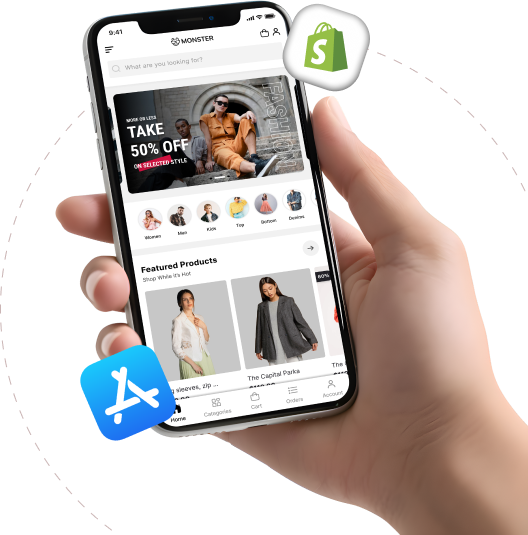Table of Contents
Businesses need to leverage technology to streamline operations and enhance customer experiences. Clover Shopify integration is an ideal way to achieve that. Clover POS is a robust point-of-sale system that businesses employ to manage sales, inventory, and customer relationships effectively.
Shopify, on the other hand, is a leading e-commerce platform that enables businesses to sell online easily. Combining these two together, you will be able to manage online and in-store sales from a single platform, improving efficiency and customer satisfaction.
This step-by-step guide will guide you through the Clover POS integration process, explain why you need it, and provide you with best practices to ensure the transition runs smoothly. You own a small business or a larger retail company; this guide will make you maximize the potential of your Clover Shopify integration.
What is Clover POS?
Clover POS solutions are designed to provide small businesses with an all-in-one solution for sales management, inventory management, and customer engagement. Embracing the concepts of simplicity and flexibility, Clover offers different hardware and software combinations that cater to different business needs. If you operate a retail store, restaurant, or service-based business, Clover POS solutions can simplify your operations and enhance customer satisfaction.
Clover’s simple interface and rich functionality make it the ideal solution for businesses looking to increase efficiency and drive sales. The platform should be easy to operate, with workers having the capability to easily learn how to use the platform to handle transactions. Furthermore, Clover Shopify integration functionalities enable businesses to integrate with various third-party programs, increasing functionality and delivering a tailored experience.
What are the Features of Clover POS Systems?
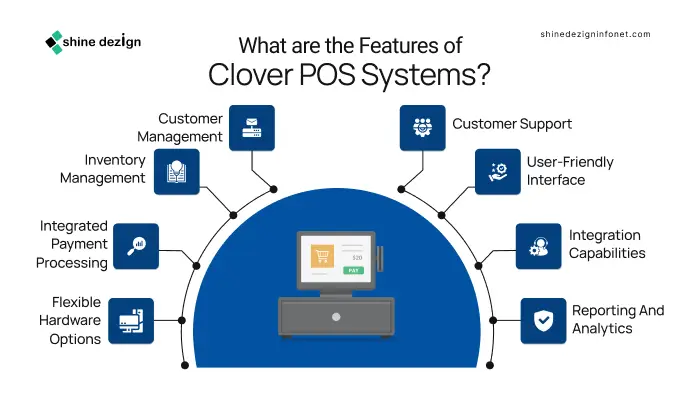 Clover POS terminals come installed with a variety of features that meet the business’s various requirements. Some of the key features are:
Clover POS terminals come installed with a variety of features that meet the business’s various requirements. Some of the key features are:
1. Flexible Hardware Options
- Clover Station: A standard POS terminal with a broad touchscreen screen, cash register drawer, and receipt printer, ideal for store environments.
- Clover Mini: A mini version of the Clover Station, ideal for limited space or mobile-friendly businesses.
- Clover Flex: A mobile payment device that allows businesses to accept payments anywhere in the store, enhancing customer convenience and service.
- Clover Go: A mobile app that converts your smartphone or tablet into a point-of-sale system, perfect for transactions on the go.
2. Integrated Payment Processing
- Payment Methods: Clover processes various payment methods like credit cards, debit cards, mobile wallets, and contactless payments, providing customers with flexibility at the point of checkout.
- Secure Transactions: Clover employs strong security features to protect sensitive customer data and ensure secure payment processing.
3. Inventory Management
- Real-Time Inventory Tracking: Monitor inventory quantities in real-time, receive low stock notices, and manage suppliers efficiently.
- Product Variants: Manage different product variations, such as size and colour, to provide customers with a full shopping experience.
4. Customer Management
- Customer Profiles: Create a customer database with purchase history and contact details to aid in more personalized marketing campaigns.
- Loyalty Programs: Create and manage loyalty programs to reward repeat business customers and enhance customer loyalty.
5. Reporting and Analytics
- Sales Reports: Generate detailed sales performance reports, allowing companies to observe trends and make informed business decisions.
- Employee Performance Monitoring: Monitor employee performance and sales data in order to optimize staffing and boost productivity.
6. Integration Capabilities
- Third-Party Applications: Clover has integration capabilities with third-party applications like accounting solutions, e-commerce websites, and marketing applications in order to allow businesses to create their own personalized environment.
- API Access: Developers have access to Clover’s API in order to create custom applications and introduce new functionality into the POS system.
7. User-Friendly Interface
- Intuitive Design: The design of Clover is intuitive, such that it becomes simple for employees to learn to operate the system and perform transactions within the least time.
- Customizable Dashboard: The dashboard can be personalized to display the most suitable information and tools to meet their business need.
8. Customer Support
- 24/7 Support: Clover offers 24/7 customer support to assist businesses with any issues or questions.
- Online Resources: Access to a wealth of online resources, including tutorials and FAQs, to help users maximize their use of the Clover system.
Why is it important to integrate Clover POS with Shopify?
Integrating Clover POS with Shopify offers numerous benefits that can significantly enhance your business operations. Here are some key reasons why this integration is essential:
1. Unified Management:
With Clover Shopify integration, you can operate offline and online sales from a single system. Having a single system combined makes operation simpler and eliminates the nuisance of having multiple systems. You are able to view sales data, inventory, and customers on a single screen; thus, you will have a clearer vision of how to make decisions.
2. Inventory Sync:
One of the most significant business struggles is inventory tracking through different selling channels. Clover POS integration with Shopify ensures that inventory levels within both systems are real-time. Such integration will prevent overselling and stock discrepancies as well, leading to improved customer satisfaction.
3. Improved Tracking:
With combined systems, you have better visibility into sales performance, customer activity, and inventory control. You can see what merchandise is moving, follow trends, and adjust your marketing strategies accordingly. It is an information-driven process that allows you to make informed decisions that can drive sales and improve profitability.
4. Streamlined Payments:
The integration simplifies payment processing by allowing customers to make payments through various means, either in-store or online. Such agility enhances customer satisfaction and can lead to sales expansion. Moreover, a single payment system reduces errors and inconsistencies in financial reporting.
5. Enhanced Customer Experience:
By linking Clover POS with Shopify, you can provide a seamless shopping experience to your customers. They can browse the web for products, check availability within the store, and make a payment with their preferred option. This ease creates loyalty and repeat business.
6. Cost Efficiency:
Having to deal with various systems is time and cost-intensive. By integrating Clover POS with Shopify, you can reduce operational costs on the maintenance of varied systems. The integration may also lead to enhanced efficiency so that your workers can focus on providing quality customer service rather than handling various systems.
How to integrate Clover POS with Shopify?
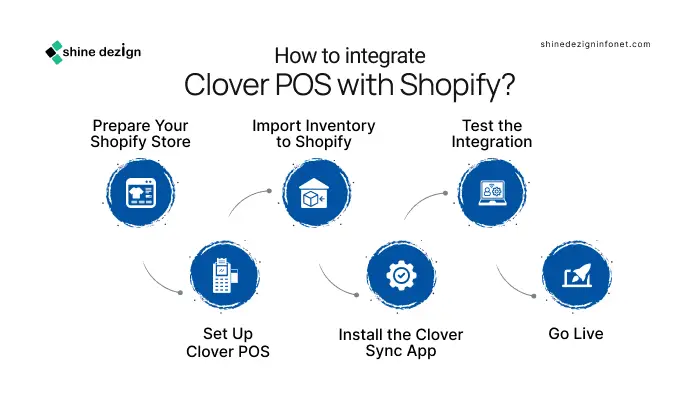 Clover Shopify integration may seem complicated, but it can be done easily with some proper procedures. Follow the following step-by-step procedure to ensure easy integration:
Clover Shopify integration may seem complicated, but it can be done easily with some proper procedures. Follow the following step-by-step procedure to ensure easy integration:
Step 1: Prepare Your Shopify Store
Before you start the integration process, ensure your Shopify store is properly set up and ready for use. The following are some of the most crucial tasks to do:
- Create a Shopify Account: Create a Shopify account, if not already created, and choose a suitable plan as per your business needs.
- Set up Store Settings: Set up your store settings like payment, taxes, shipping, etc., as applicable.
- Add Products: Upload products in your store with descriptions, images, and pricing.
Step 2: Set Up Clover POS
Ensure your Clover POS system is up and that you are able to access the Clover dashboard. The following are the steps to follow:
- Log in to Clover Dashboard: Log in to your Clover account and navigate to the dashboard.
- Export Inventory Data: If you have some inventory already in Clover, export this data as a CSV file. This file will be used to import your inventory into Shopify.
Step 3: Import Inventory to Shopify
In order to keep the inventory consistent on both platforms, you will need to import your Clover inventory to Shopify. These are steps you can undertake:
- Reformat the CSV File: Ensure the CSV file that you exported from Clover is compatible with Shopify’s import requirements. You may need to transform column headers and data types.
- Use Shopify Import Tool: Navigate to your Shopify admin panel and go to the “Products” section, and use the import tool to transfer your reformatted CSV file. This will import your Clover inventory into your Shopify store.
Step 4: Install the Clover Sync App
As a step in helping the integration of Shopify and Clover be seamless, you will install the Clover Sync app. Here’s how you can install it:
- Go to Shopify App Store: Go to the Shopify App Store and find the Clover Sync app.
- Install the App: Choose the app and follow the instructions to install it. You may be asked to grant permissions for the app to access your Clover account.
- Connect Your Accounts: Once the app is installed, follow the prompts to connect your Clover account with Shopify. This process may involve logging into your Clover account and authorizing the connection.
Step 5: Test the Integration
Before going live, it is crucial to test the integration to ensure everything is functioning correctly. Here’s what to do:
- Run Test Transactions: Run test transactions in both Shopify and Clover to confirm that sales information is syncing correctly.
- Check Inventory Levels: Double-check that inventory levels are syncing in real-time in each system. Fine-tune as necessary.
- Verify Payment Processing: Run all payment types through to confirm that they are processing correctly in each system.
Step 6: Go Live
Once you have completed testing and are confident that the integration is performing as it should be, it is time to go live. A few tips for a successful launch are:
- Choose a Low-Traffic Day: Choose a low-traffic day to switch over. This will allow you to fix any problems that occur without affecting your operations.
- Train Your Employees: Ensure that each employee is trained to use the new system. Give them support and resources to adjust to the change.
- Watch Over the Systems: Once live, keep sales and inventory under close observation to detect discrepancies early. Make sure to be able to fix any problems during the first few days of operation.
What are the Best Practices of Integrating Clover POS with Shopify?
To ensure a seamless Clover Shopify integration, implement the following best practices:
Plan Ahead:
Create a detailed plan for the migration, such as timelines, responsibilities, and the most important milestones. Planning will keep you properly organized and ensure that every step of the integration is addressed.
Test Thoroughly:
Conduct several test transactions to find and solve any issues prior to going live. Testing is crucial to ensure that your systems are working well and that your workers feel comfortable with the new setup.
Train Staff:
Ensure all employees feel comfortable working with the new system to minimize disruption. Provide training sessions and resources to allow them to adjust to the changes.
Backup Data:
Keep a copy of your Clover data in case you need to revert to the old system for a short while. This action will avoid data loss during the transition.
Monitor Performance:
After the transition, monitor sales and inventory closely to catch any anomalies early. Monitor reports and analytics regularly to catch trends and make informed decisions.
Seek Assistance:
If you are having problems along the way of integrating, do not shy away from contacting the support divisions of both Shopify and Clover. They will be able to guide you and offer very useful advice.
Summing Up
Clover Shopify integration can have a significant impact on your business processes by consolidating all your sales into a single hub. By following the steps outlined in this guide and adhering to best practices, you can ensure that your migration is seamless and increase overall productivity. The benefits of this integration, including improved stock management, seamless payments, and improved customer experience, make it a worthwhile investment for any retail business.
As you continue on this integration path, keep in mind that technology is something that can serve to support your business objectives. Welcome the changes, get your employees trained, and use the learnings from your integrated systems to propel growth and success.


